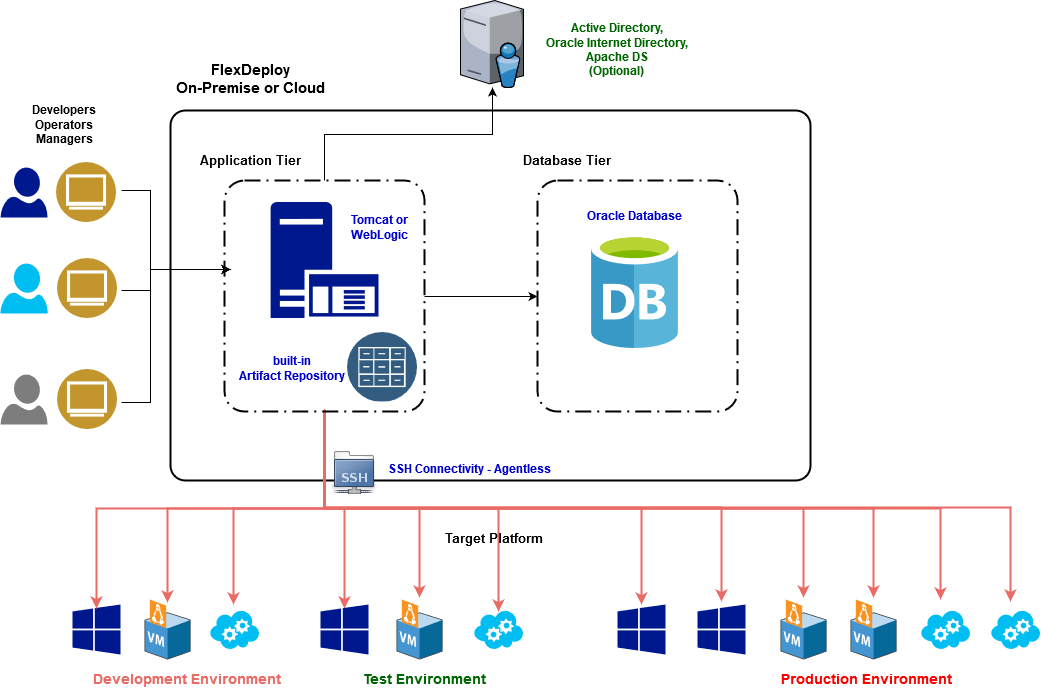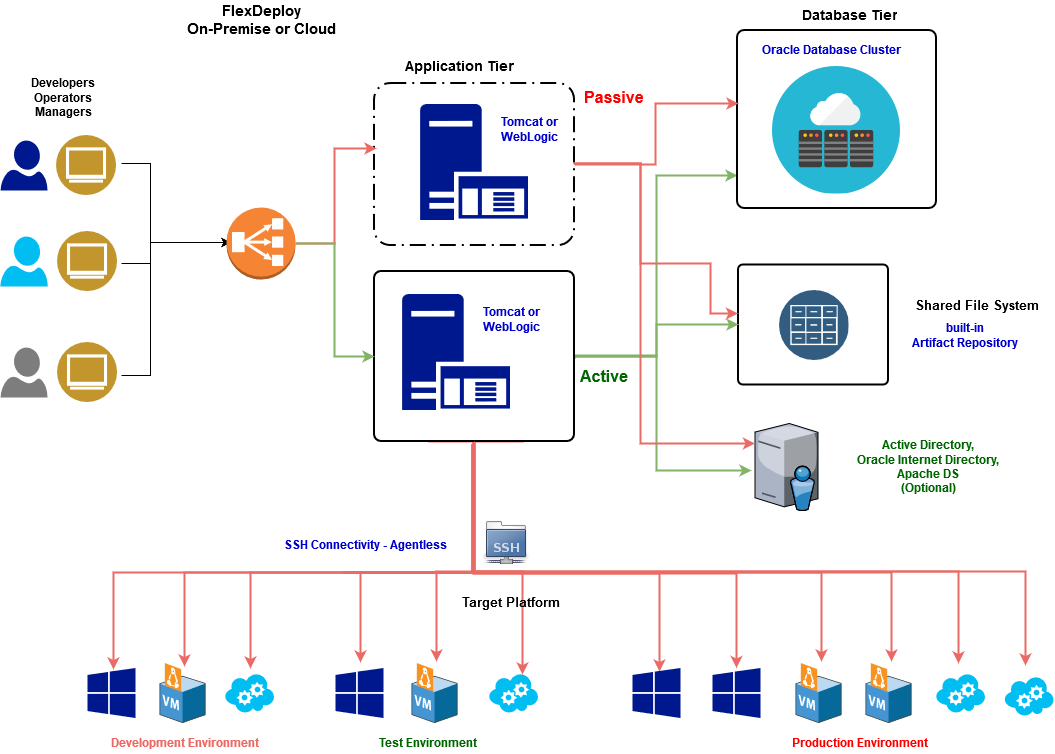FlexDeploy Installation Guide
The FlexDeploy™ Installation Guide provides system specifications and instructions for installing FlexDeploy and its components.
FlexDeploy Architecture
FlexDeploy is a Java-based web application which requires an Application server (WebLogic or Tomcat) and an Oracle database. FlexDeploy is accessed by Browser and can be integrated with various Directory Servers for Authentication and Authorization, but you can also work with local security realm provided by FlexDeploy.
FlexDeploy uses built-in File System based Artifact Repository to store build artifacts like jar, ear, war, zip etc. Build artifacts are versioned and used during deployment.
FlexDeploy connects to target servers using SSH protocol and only requires Temporary Working Directory and Java for execution on target servers. SSH connectivity to Windows servers is established using Cygwin, i.e. Cygwin must be installed on Windows targets.
FlexDeploy can be installed On-Premise or in Cloud (AWS, Azure, Oracle) and can be used to perform Build / Deploy on targets in On-Premise or Cloud as only SSH connectivity is required.
FlexDeploy has plugin architecture which allows for integration with various technologies. FlexDeploy comes with many out of box plugins, but customers are free to developer their own plugins using Plugin SDK.
Database Tier
FlexDeploy requires one of the following Oracle databases, and any required license is not included with your FlexDeploy subscription.
- Oracle XE, version 11.2 (although supported for production use, XE is generally used for trials and proof of concepts)
- Oracle Standard, version 11.2
- Oracle Enterprise, version 11.2
- Oracle Standard, version 12.1
- Oracle Enterprise, version 12.1
- Supported platforms
- Any platform supported by Oracle Database
Application Tier
FlexDeploy requires one of the following application servers. You must install FlexDeploy on only one application server process, i.e. cluster is not supported.
- WebLogic 12.1.3 (license is not included with your FlexDeploy subscription)
- Tomcat 8.x
- Supported platforms
- Microsoft Windows
Unix/Linux (and its variants, such as Oracle Enterprise Linux, Red Hat, Solaris, etc.)
- VM Image (ova) file with FlexDeploy is also available to quickly start trial of FlexDeploy. If you are interested in a FlexDeploy VM Image, please contact us through our website or download it here.
Target Endpoints
FlexDeploy requires SSH connectivity using User and Password or SSH Key. Additionally, some minor items are required on target endpoints.
- Working folder for temporary files..
- JDK 6 or higher.
- Supported platforms
- Microsoft Windows
Unix/Linux (and its variants, such as Oracle Enterprise Linux, Red Hat, Solaris, AIX etc.)
- Mac OS
High Availability Considerations
Here are some guidelines on Active Passive configuration for FlexDeploy, as running more than one server process for FlexDeploy is not yet supported. You can choose to setup Cluster for Application or Database or Both.
- Install FlexDeploy application on two separate Physical Server or Virtual Machines.
- WebLogic
- Install two separate WebLogic Domain to two distinct Managed Servers in single WebLogic domain.
- Deploy FlexDeploy application to both Domains or Managed Servers.
- Tomcat
- Install two separate Tomcat as per Installation instructions.
- Both installation will have configuration for JDBC connection to RAC database.
- WebLogic
- Setup RAC Database cluster for FlexDeploy.
- Make sure to use JDBC connect string for RAC cluster nodes when defining Data Source definitions.
- Use Shared File System for Artifact Repository directory. There is no need to setup Working directory on Shared File System.
- Configure Load Balancer to route all FlexDeploy users to Active Application Server. You can automate the process of fail over to Passive node if necessary.
- Make sure that only one of the Application Server process is running. This is absolutely necessary even when Load Balancer is routing traffic to only one of the server.
- This can be achieved by leaving out some configuration details on the Passive node. For example, you can omit Data Source configuration on Passive node, so that it does not start processing request if it is started by mistake.
Downloading FlexDeploy
For customers with active subscriptions, FlexDeploy can be downloaded from the Flexagon Support Site.
For the community (free) edition, you can contact us through our website or download the software directly here.
FlexDeploy System Requirements
Database Tier Requirements
FlexDeploy requires one of the following databases to be installed and running.
- Oracle XE, version 11.2
- Oracle Standard, version 11.2
- Oracle Enterprise, version 11.2
- Oracle Standard, version 12.1
- Oracle Enterprise, version 12.1
Application Tier Requirements
Working Directory
FlexDeploy uses a working directory for temporary files to be transferred between the server and its endpoints. This directory needs to have at least 4GB of space available on the FlexDeploy Server.
- As this file system contains only temporary files, there is no reason to backup this directory.
- Availability of space within the server working directory is critical to functioning of the FlexDeploy platform. Therefore, the filesystem should be monitored and space should be allocated as necessary. In addition, it is recommended that this be a separate mount point.
- Files in this directory which are older than one day will be purged automatically to help effectively manage the size.
Artifact Repository
The FlexDeploy artifact repository is a directory available on the FlexDeploy server where all build artifacts are stored, and later retrieved for the deployments. This directory needs to have at least 10GB of space available on the FlexDeploy Server.
- Due to the importance of the artifact repository, this file system should be backed up regularly.
- Availability of space within the Artifact Repository is critical to the creation of new build versions. It is highly recommended to have a file system size monitor in place for this directory, and size should be adjusted based on the number of builds created, and the size of the artifacts produced. In addition, it is recommended that this be a separate mount point.
Application Server
FlexDeploy is Java web-based application, you can setup either WebLogic or Tomcat to install FlexDeploy.
WebLogic
- WebLogic 12.1.3 including JRF (ADF Runtime) 12.1.3 (See WebLogic 12.1.3 Installation Scripts for installation and configuration of WebLogic 12.1.3 domain)
- 8GB of RAM
- 1 CPU
- JDK 1.7.0+ (Use latest patch for JDK 1.7, for additional certifications, see 12.1.3 Certification Matrix)
Tomcat
- Tomcat 8+ (Tomcat 8.5.x was rigorously tested, and therefore, recommended). If you follow Installing FlexDeploy with included Tomcat, you do not have to separately install Tomcat.
- 8GB of RAM
- 1 CPU
- JDK - refer to http://tomcat.apache.org/whichversion.html for selecting. Tomcat 8.5.x was tested with JDK 1.7_67, 1.8_60 and 1.8_101.
Endpoint Requirements
An Endpoint is a target server where FlexDeploy can perform build or deploy activities. Endpoints are configured within the FlexDeploy UI. See following requirements for each Endpoint.
Requirements
- JDK version 1.6 or higher
- Disk space on each endpoint of 4GB. There is no need to monitor this file system as FlexDeploy will automatically perform cleanup.
Operating Systems
- Microsoft Windows. For Windows endpoint, cygwin must be installed on target see FlexDeploy Cygwin Install Guide.
- Unix/Linux (and its variants, such as OEL, RedHat, Solaris, AIX, etc.)
- SSH connectivity either using User / Password or using SSH Keys.
Installation Instructions
On-Premise or IaaS Installation
- Installation Instructions - Database Tier
- Installation Instructions - Application Tier
- Endpoint Configuration
- Loading FlexDeploy Plugins
FlexDeploy Installation with included Tomcat
This allows for very quick installation as Tomcat is already included and you just have to update few minor configurations.
Oracle Java Cloud Service (PaaS) Installation
See Oracle Java Cloud Service Installation.
- Creating an Oracle Database Cloud Service Instance
- Creating an Oracle Java Cloud Service Instance
- Installation Instructions - Database Tier
- Installation Instructions - Application Tier
- Endpoint Configuration
- Loading FlexDeploy Plugins
Using FlexDeploy VM Image
VM Image (ova) file with FlexDeploy is also available to quickly start trial of FlexDeploy. If you are interested in FlexDeploy VM Image, please contact us through our website or download it here. See Using FlexDeploy VM Image for details on how to use VM Image.
- style

